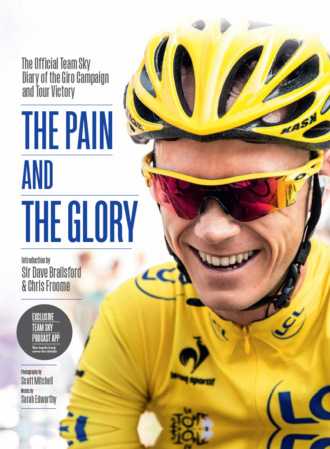
Полная версия
The Pain and the Glory: The Official Team Sky Diary of the Giro Campaign and Tour Victory

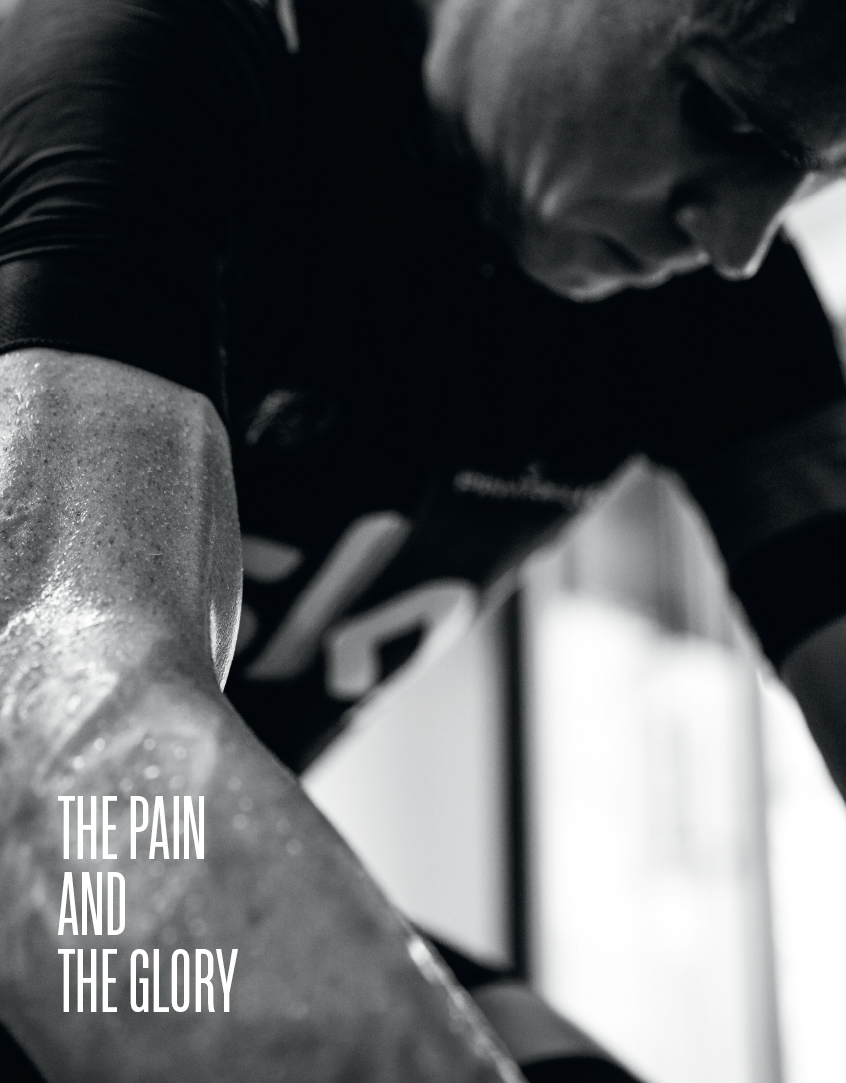
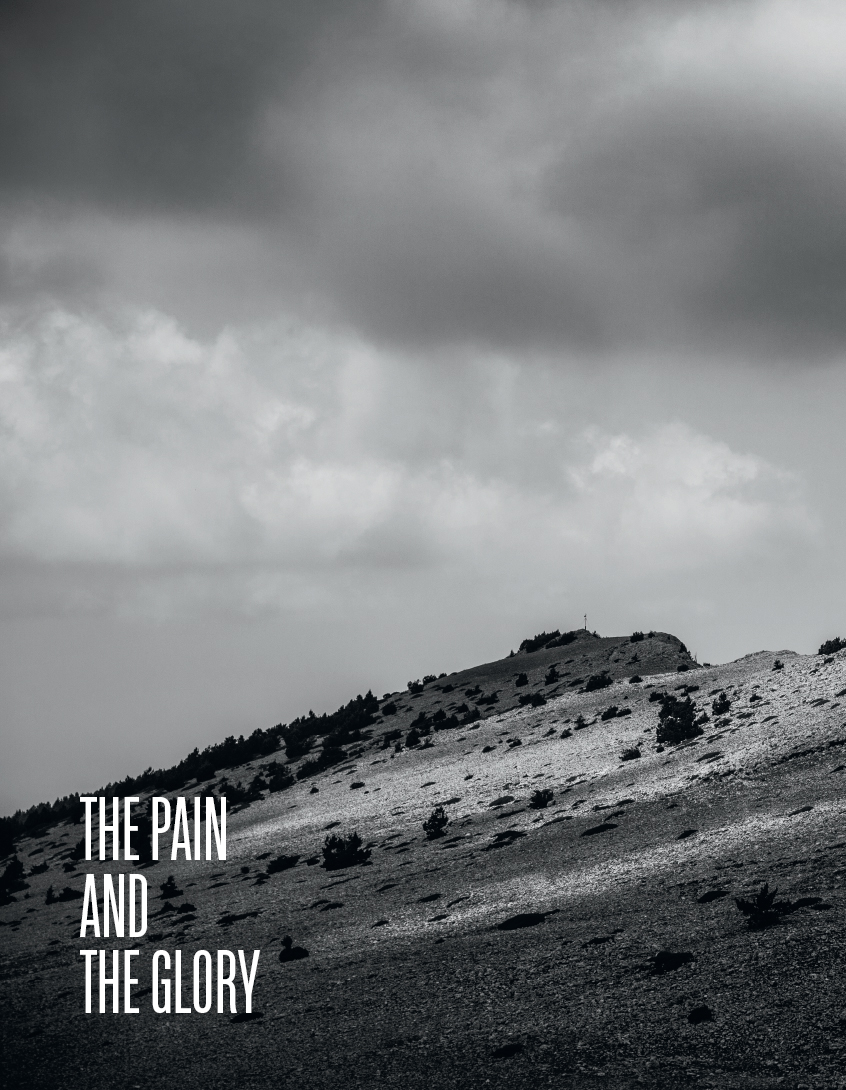
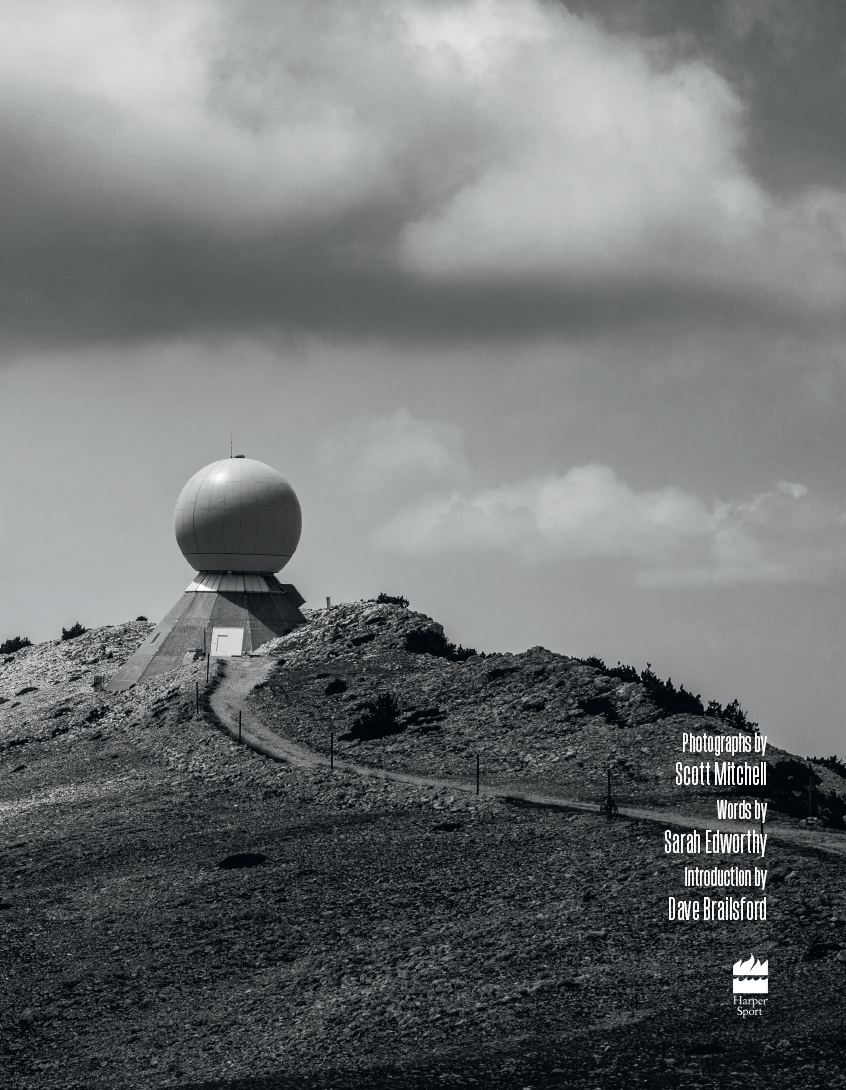
CONTENTS
COVER
TITLE PAGE
INTRODUCTION BY DAVE BRAILSFORD
THE STORY OF THE GIRO
THE GIRO ROUTE
STAGE 1
STAGE 2
STAGE 3
STAGE 4
STAGE 5
STAGE 6
STAGE 7
STAGE 8
STAGE 9
STAGE 10
STAGE 11
STAGE 12
STAGE 13
STAGE 14
STAGE 15
STAGE 16
STAGE 17
STAGE 18
STAGE 19
STAGE 20
STAGE 21
THE GIRO IN DETAIL
STAGE 1
STAGE 2
STAGE 3
STAGE 4
STAGE 5
STAGE 6
STAGE 7
STAGE 8
STAGE 9
STAGE 10
STAGE 11
STAGE 12
STAGE 13
STAGE 14
STAGE 15
STAGE 16
STAGE 17
STAGE 18
STAGE 19
STAGE 20
STAGE 21
THE STORY OF THE TOUR
THE TOUR ROUTE
STAGE 1
STAGE 2
STAGE 3
STAGE 4
STAGE 5
STAGE 6
STAGE 7
STAGE 8
STAGE 9
STAGE 10
STAGE 11
STAGE 12
STAGE 13
STAGE 14
STAGE 15
STAGE 16
STAGE 17
STAGE 18
STAGE 19
STAGE 20
STAGE 21
THE TOUR IN DETAIL
STAGE 1
STAGE 2
STAGE 3
STAGE 4
STAGE 5
STAGE 6
STAGE 7
STAGE 8
STAGE 9
STAGE 10
STAGE 11
STAGE 12
STAGE 13
STAGE 14
STAGE 15
STAGE 16
STAGE 17
STAGE 18
STAGE 19
STAGE 20
STAGE 21
COPYRIGHT
ABOUT THE PUBLISHER
INTRODUCTION BY DAVE BRAILSFORD
Coming into Paris in the dark to seal our second successive Tour de France victory was different, that’s for sure – a special moment to savour. It was a brilliant story last year when Bradley Wiggins became the first Briton to win the greatest prize in cycling, but to return with a different leader and win in consecutive years, in the historic 100th edition of the race, created a deep sense of achievement for everyone at Team Sky.
From the outside, those three weeks that Chris Froome ultimately dominated might have looked controlled, but from the inside they felt pretty epic. After the first Pyrenean stage, during which strong teamwork enabled Chris to show his superiority, something dramatic happened every single day. There was a tremendous sense of pride for the behind-the-scenes staff in witnessing the spectacle when the riders crossed the line with linked arms on the Champs-Élysées. Going on a Grand Tour means living together 24/7 for almost four weeks. It’s like a soap opera, with a real sense of shared endeavour and camaraderie. After being in that kind of rhythm, it was wonderful to celebrate the magnitude of the occasion as a team.
In 2010 we launched Team Sky as a professional road-racing outfit with the aim of a clean British rider winning the Tour de France within five years. I said last year that you couldn’t script a more perfect way of realising this ambition than that moment on Sunday 22 July 2012, when Mark Cavendish won on the Champs-Elysées, led out by his team-mate Bradley Wiggins in the yellow jersey. That milestone Tour triumph came together in just three years, and for the team now to have done it twice – and to witness Chris Froome standing on the podium in the centenary edition alongside fivetimes winners Eddy Merckx, Bernard Hinault and Miguel Indurain – is amazing.
There is a deep sense of community among the Team Sky outfit. As a team we worked on a very refined model in 2012, bound by our philosophy. This year we tried to scale that up and have a broader service provision so that we could have a good go at the other Grand Tours – the Giro d’Italia and the Vuelta a España. Before the season starts you look at 27 riders. Each Grand Tour only needs nine riders. The trick is to optimise resources against the goals we’ve set. Bradley’s goal for 2013 was to win the Giro. Chris’s sole objective was the Tour de France. You make plans a long way out and sometimes life gets in the way, but we put in a dynamic framework that allows us to amend plans if necessary.
We went to the Giro with pre-race speculation bubbling about whether it would be Vincenzo Nibali or Bradley first or second in Brescia. After Bradley’s unfortunate withdrawal through illness, we still achieved second on the podium with Plan B and Rigoberto Urán, which was a terrific result. You could see the team’s trademark action during the epic stage that Rigoberto won, when we used strength in numbers to go on the attack and execute a pre-planned move. The lads worked hard and Rigoberto went at exactly the right time, gaining a chunk of time with his first GT stage win in Altopiano del Montasio. We took away a lot of positives from our quest for the maglia rosa.
The 100th edition of the Tour de France meant it was a symbolic race. It was also the first since the Lance Armstrong revelations. It’s a strange situation: the sport is cleaner now than ever but, because of the revelations of past riders, it’s getting closer scrutiny and the current riders are having to take this because of the misdemeanours of the past. Reporters have a duty to ask the questions, but they also set the tone. Riders are smart enough to understand why they’re being asked, but it still doesn’t make it easy.
Otherwise, going into the Tour felt similar in many respects to last year: Chris’s brilliant run-up replicated the wins achieved by Bradley in 2012. Chris, too, hit the race as pre-Tour favourite. Instead of thinking it was our title to defend, which would have been a negative mindset, we went out to try and win it a second time starting from zero. That gave us a more positive way of looking at it. Bradley, the reigning champion, was unable to compete; Chris was coming up through the ranks, very hungry, very driven.
Chris had been second in the Vuelta in 2011, second in the Tour in 2012. Having set his sights on winning the 2013 Tour, he demonstrated an amazing growth in self-belief. He concentrated on learning how to be a race and team leader. He put himself in situations against the best riders in the world and he wasn’t afraid to take them on. When you’re riding to support a leader who can take it on, it’s a great cause. The team had difficult days, yet Chris stayed absolutely calm. He’d say, ‘No worries, we’re in control.’ The art of leadership is not to show anxiety or concern, but to do what it takes to achieve your goal. Chris proved he was the best bike rider in the race. No issue.
Skip photographs
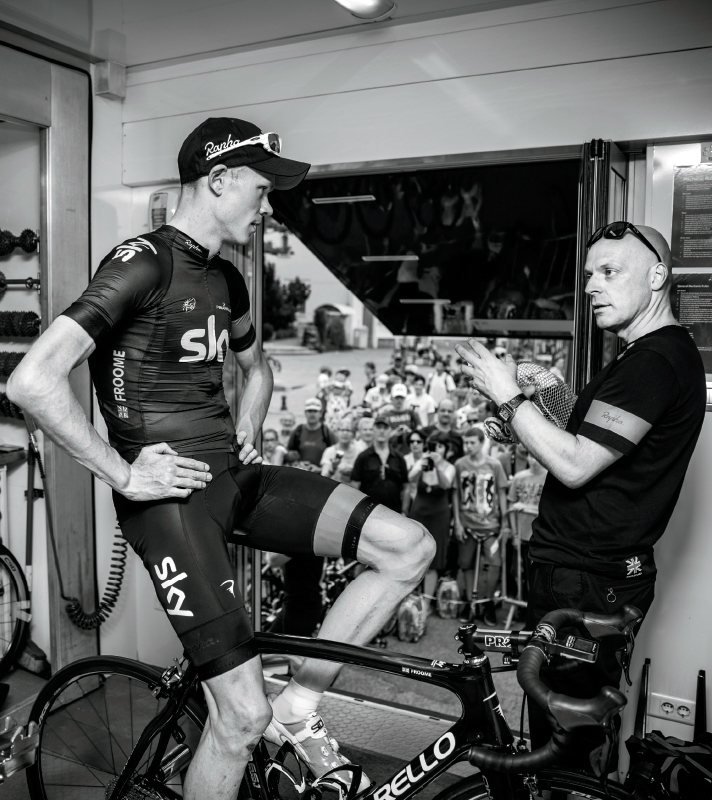
THE STORY OF THE GIRO
THE GIRO ROUTE
STAGE 1
The Giro d’Italia. La Corsa Rosa. The toughest Grand Tour of them all. Never mind its bubble-gum branding, the Italian job is the Tour de France’s monster brother. The crazy one. A race that serves up brutal climbs, perilous descents, fraught finishes, extremes of weather, depths of anguish. And on Saturday 4 May 2013 – under azure skies, with Mount Vesuvius looming portentously in the background – it was Grande Partenza time, the moment the clock starts ticking and the contest begins.
Over the course of 21 days of relentless race and recovery, one individual from the throng of 207 tautly primed riders rolling out on the Naples seafront would arrive at the finish in Brescia, a tired body but elated spirit, having pedalled himself into cycling’s history books.
The Grande Partenza was also the start of the tale of what Sir Bradley Wiggins did next. Shorn of hair and trademark sideburns, the Team Sky leader was in combat mode as he prepared to take on the nerve-inducing jostle of fresh riders, the responsibility of never having a bad day, and embark on three weeks that could cement his place among the greats. Looking to follow up his Tour de France and Olympic triumphs of 2012, he had set his sights on becoming the first Briton to win the famed maglia rosa. The experience of claiming the yellow jersey and a gold medal within ten magical days was unsurpassable, but Wiggins still had unfinished business. The Giro held a ‘love–hate’ appeal for him. Fuelled by childhood memories of the heroics of Miguel Indurain on VHS and by his own thwarted attempts (elimination in 2003, early crashes in 2010), the goal was to add the Giro to his unparalleled palmarès.
‘The Giro has always been a race I’d love to win,’ he said, before the nine-strong squads from 23 teams gathered to sign in. The daunting stretches he’d ridden in preparation prompted a doleful afterthought. ‘There have been times, even though I’m physically in great shape, when I think, “Why on earth did I choose to do this bloody race?”’
The annual quest for the maglia rosa is the stuff of legends. Beyond the business of staying on the bike in the hurly-burly of racing full gas over Italy’s challenging terrain, the Giro also comes laced with gruelling transfers, narrow roads, an air of potential chaos. ‘I was super-nervous,’ said Dan Hunt, one of Team Sky’s sports directors. ‘You’re walking into the unknown. You don’t know how it will pan out. For me, the first week was the equal of the Olympics in terms of external pressure, because Brad was going out to win the Giro. It’s one thing to compete in a Grand Tour. It’s difficult going in to win. The world wanted to see if Brad and Team Sky could achieve it.’
With Wiggins anticipating ‘the usual carnage’, he began his assault confident in the team around him. The Colombian climbing specialists Rigoberto Urán and Sergio Henao (who came seventh and ninth respectively in the 2011 Giro) would provide support in the mountains. Christian Knees of Germany was road captain; the versatile Kanstantsin Siutsou of Belarussia a trusted lieutenant. Danny Pate of the United States added an experienced understanding of peloton dynamics. Xabier Zandio of Spain contributed a powerful engine and a big heart. The Italian duo of Dario Cataldo, national time trial champion, and the youngster Salvatore Puccio, would generate a buzz in their home race.
Nearly three hours after passing kilometre zero, the tight and twisty 156km opener served up a fierce sprint finale and a slingshot winner in Mark Cavendish. Team Sky emerged intact. ‘It was a bit hairy, as expected, but we made it through,’ said Wiggins. One down, 20 to go.
Skip photographs
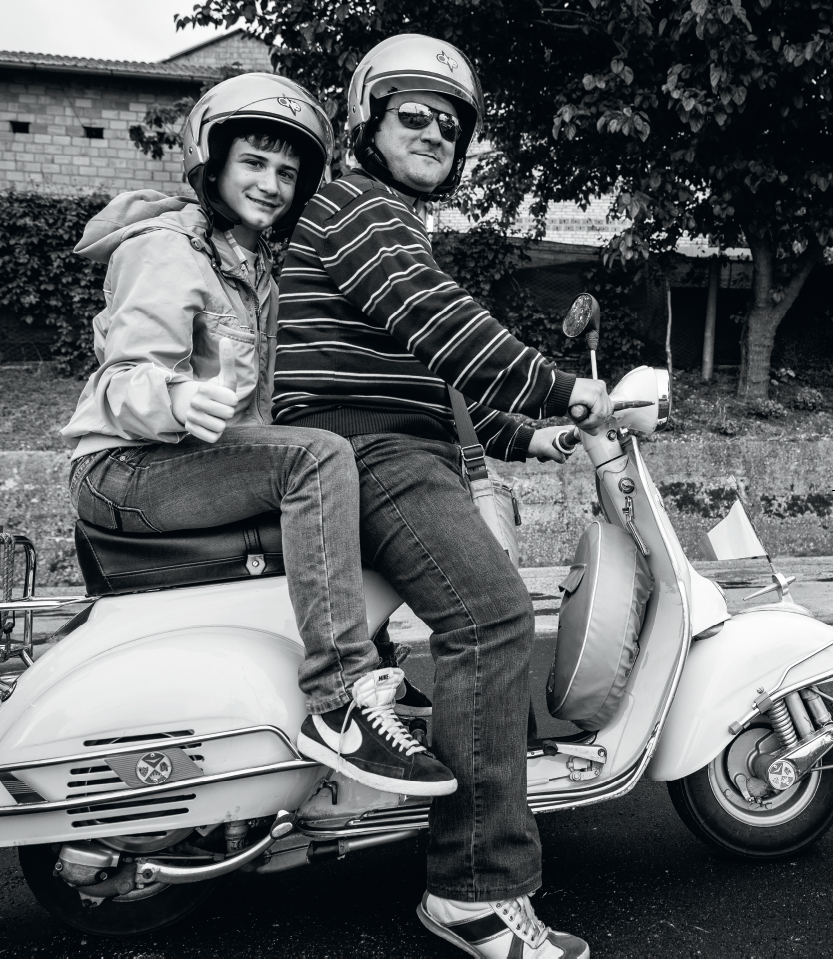
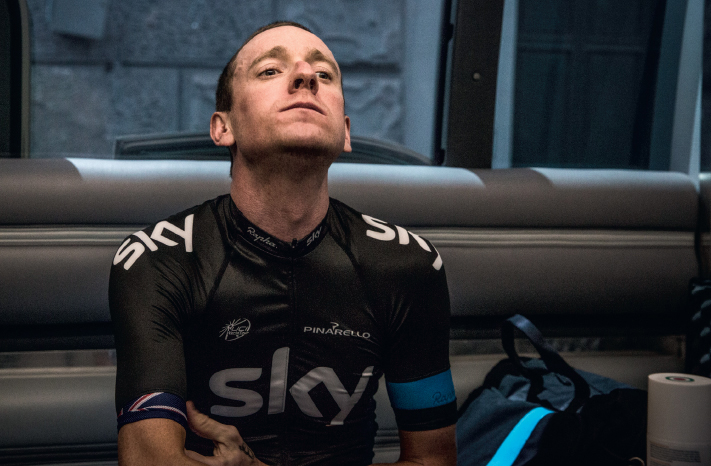
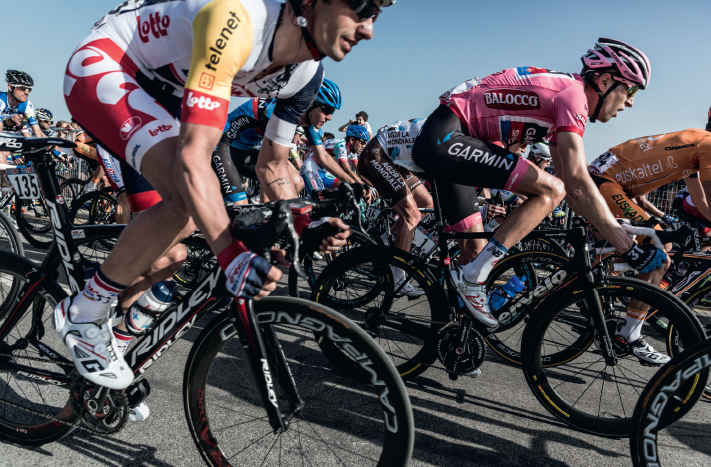
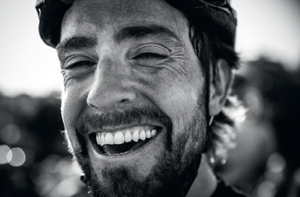
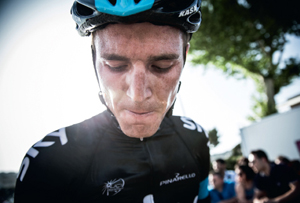
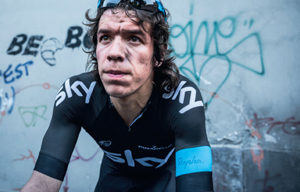
STAGE 2
A team time trial requires a series of short, intense efforts as riders take turns at the front of their train. This one, hosted by the island of Ischia, also called for strong stomachs. It would be an early wake-up call and a long day for the riders and attendant Giro circus because of the need to sail by ferry to Ischia and then back to Sorrento on the mainland, south of Naples, ready for the next day’s road stage to Marina di Ascea.
‘The team time trial is known as the worst day on a Grand Tour because it’s hectic, nervy and very, very stressful. A lot more can go wrong than go right. It was going to be 17.4km right on the rivet,’ said Hunt, who was bringing his clinical approach as former head of the GB men’s team pursuit squad to this choreographed race feature.
Rigoberto Urán concurred. ‘Team time trials are very complicated in the management of different people’s strengths,’ he said. ‘We’ve a mixture of climbers, workers and time trial specialists. Bradley is so strong; he was going to do a lot of the work, but get the distribution of effort wrong and it can be painful. If you’re not 100 per cent, it’s agony, because you’re at full gas the whole distance. But we managed that well . . . and that’s why we won.’
Wiggins, Urán, Cataldo, Henao and Puccio crossed the line together in a time of 22 minutes and 5 seconds, set up brilliantly by turns from Pate, Knees, Siutsou and Zandio. The victory established a 9 seconds margin over Movistar and 14 seconds over Vincenzo Nibali’s Astana. ‘It was a big highlight, really cool to be part of that,’ said Pate. ‘Puccio in the pink jersey! He was over the moon – and he’s a very stereotypical Italian!’
As if proof of the Giro’s inherent unpredictability, it was young Salvatore Puccio – not Dario Cataldo, Team Sky’s Italian national time trial champion – who was awarded the maglia rosa. ‘There was confusion because Dario was the first rider across the line but Puccio was the leading Team Sky rider after the first stage,’ said Knees. ‘Dario had been sent to wait by the stage for the podium ceremony. Salvatore was in the shower when I heard the commentator confirm the results. I had to knock on the shower and tell Puccio he’d won the jersey. He was saying, “No, no, no, it must be Dario,” and I was yelling, “No, it’s you, quick, get out of the shower!”’
‘Salvatore was absolutely flummoxed. He, we, didn’t expect it,’ says Hunt. ‘Sky had never won a team time trial in a Grand Tour before, so it was a first, a great day for the team. To see Salvatore in pink was the icing on the cake.’
After the podium ceremony, Puccio fulfilled his media obligations, including an extensive interview with La Gazzetta dello Sport. Accompanied by team doctor Richard Freeman, he then had to report to doping control and missed the ferry back to the mainland. ‘The organisers had a speedboat ready to take him to Sorrento,’ laughs Hunt. ‘The doc lived it up, lounging on the back of the boat like a playboy, but Puccio was seasick!’
Skip photographs
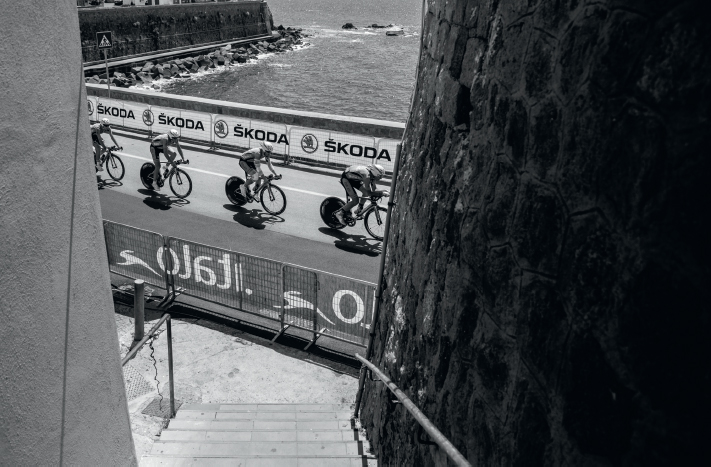

STAGE 3
Morale was high for the first foray into medium mountains with Team Sky’s Giro débutant still incredulous that he would be the one wearing the iconic maglia rosa. Puccio had gone to sleep with the jersey on the seat next to his bed, pinned up with his race numbers ready for the next stage. At the morning meeting in a hotel bedroom, he was the only one not wearing a jersey. The pink pile of fabric remained bundled by his side until the others left the room and he enjoyed the private moment of pulling it on over his head, tweaking the fit and admiring himself in the mirror. Downstairs in the lobby, his father, girlfriend and best friends were waiting to surprise him; they had set off at 4am and driven six hours to make his day even more special. ‘It is a great honour to wear the maglia rosa,’ he said. ‘As this is my first experience in the Giro, it took time to understand all this was reality and not a dream.’
‘It was a nice day for “Baby Puccio”,’ said Knees. ‘The Gazzetta dello Sport called him that in their report and I took it up and ran with it. He hadn’t dreamed he’d be in pink, and now he had a pink helmet, pink saddle and pink grip on his handle bars!’ The tifosi in Sorrento town centre were buzzing. In a race that boasted a strong international field, the race leader’s jersey was on the back of an Italian for the first time in 2013. Standing out in that distinctive pink – even above the assembled mass of dayglo team kits and helmets – Puccio was loving every minute of the experience, receiving congratulations from riders, fielding banter from fellow Italians, waiting under the rose-tinged shade provided by an official umbrella girl for the signal to roll off. The great thing for Wiggins and the GC contenders – Nibali, Cadel Evans and defending champion Ryder Hesjedal – was that the home media had an alternative focus away from the intense speculation about their rivalry and form.
Looking at the course, analysing its demands and assessing the attributes required for a serious campaign are an exercise all the teams undertake as soon as the race route is published. The 2013 Giro d’Italia had its traditional quotient of massive mountains – ‘They tend to find new super-steep climbs each year,’ notes senior sports director Marcus Ljungqvist – but it also had a fair amount of time trialling. This would normally play into the hands of Wiggins, but Nibali, third behind Wiggins and Chris Froome in the 2012 Tour de France, was super-motivated to take the challenge to the British knight.
Riding on home soil, for a new team, Astana – which had built itself around its lead rider’s ambitions – Nibali had worked doggedly at improving his time-trialling performance so that he could consolidate the advantages his steely descending prowess would doubtless win him. He arrived in Naples on tremendous form, having won the Tirreno–Adriatico (holding off Froome in the final time trial) and the Giro del Trentino, and had sent the odd psychological salvo in Wiggins’s direction. There was no doubt he meant business.
Cadel Evans, ultra-competitive in spirit but recovering from a virus, came in with only five weeks of dedicated training compared with other contenders’ six months or so and admitted his entry was ‘a bit of an experiment’. Race form was also a question mark over Ryder Hesjedal, as was the amount of time trialling (not his speciality) in this edition of the Giro. Samuel Sánchez’s legendary appetite for courageous descending put him in the mix even at the age of 35. But pre-Tour speculation evaporated in the edginess of the third day. The Giro had not yet developed a rhythm. Teams had not shown their cards. It wasn’t clear who had good legs. It was all about the here and now, with everyone trying to stay safe.
An early seven-man breakaway led the peloton by more than 6 minutes when Team Sky, Katusha and Omega Pharma-Quick Step took turns to up the tempo at the front. Wiggins, Nibali and Hesjedal were visible in the lead group. Hesjedal twice attacked, but happily slotted back into the pack, before Luca Paolini – leaving the big guns to stalk and unnerve each other with surprise bursts and dummy moves – escaped with a late attack on the descent.
It was a day bookended by two Italian Giro debutants in pink as Baby Puccio surrendered the jersey to his compatriot, 36-year-old Paolini. ‘We knew there would be a lot of teams going for it at the end and that’s how it played out,’ said Ljungqvist. ‘It was always going to be a tough finale. We set a tempo at the front, and Xabi and Danny did a great job to control things there with the breakaway up the road. Today was really nice for Puccio but now we’re back to looking after Brad and making sure we’re ready for the hard days coming up.’
Skip photographs
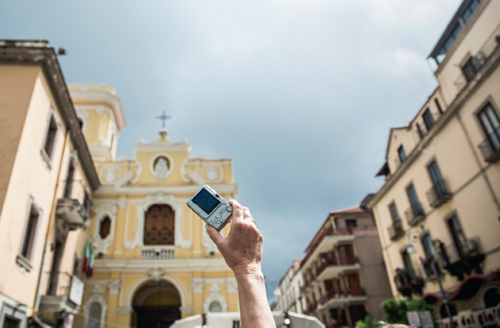
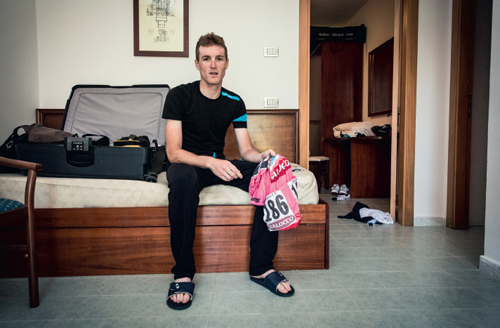
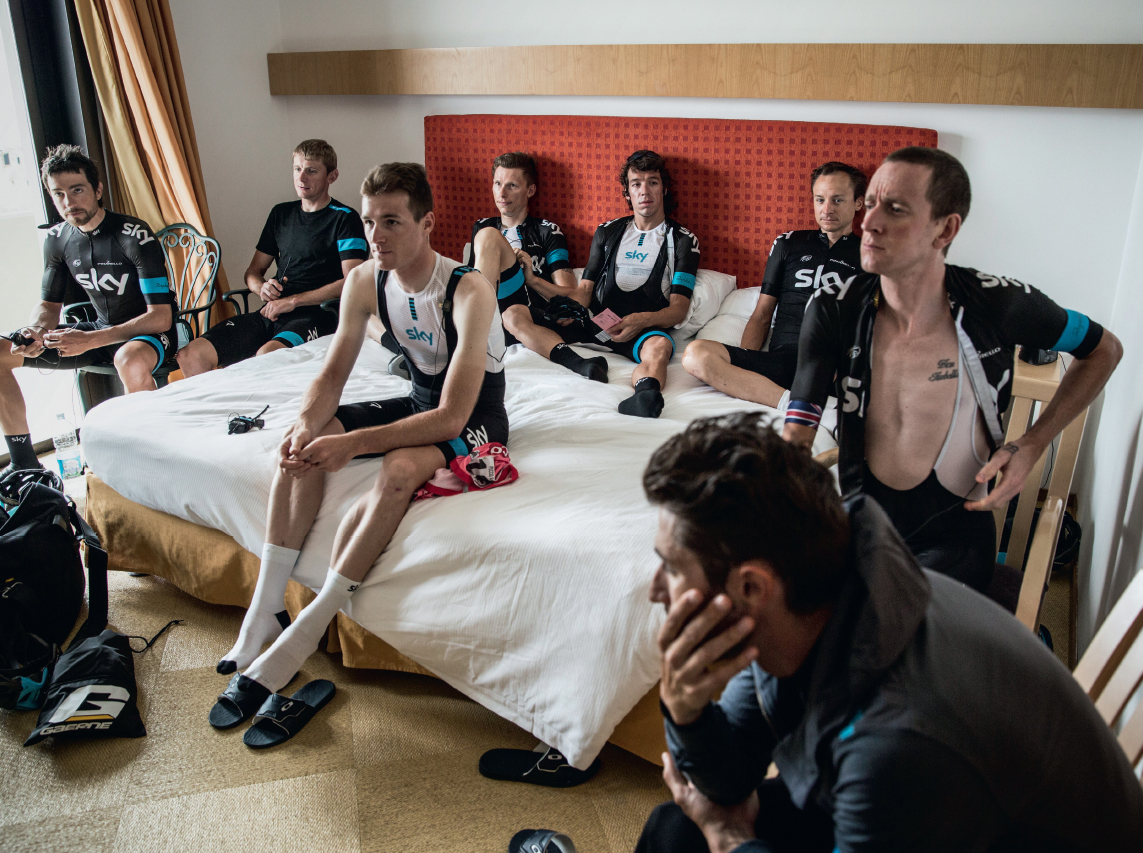
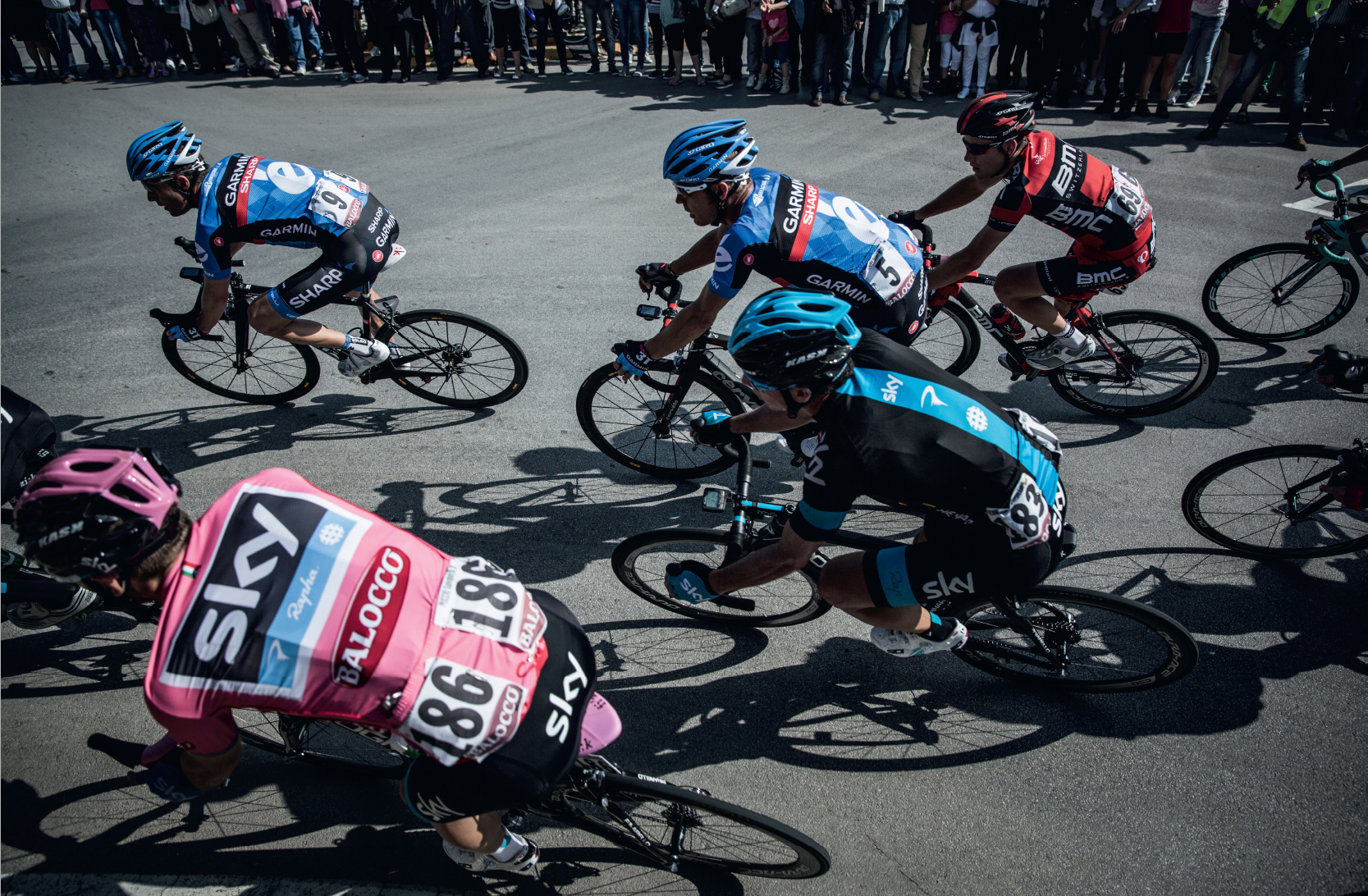
STAGE 4
The Giro always throws in a couple of hard stages early on, and the 246km stage from Policastro Bussentino down the Mediterranean coast to Serra San Bruno was a trademark shocker. As legs were beginning to long for the masseur’s attention on the second-longest stage of the race, up loomed the Category-3 climb of Vibo Valentia, followed by the Category-2 challenge of Croce Ferrata and a 7km downhill run to a finish on cobbles. ‘The Giro finishes are always a bit more technical,’ warned team principal Sir Dave Brailsford. ‘You have to be on your guard, focused and concentrated, ready for any attack at any time.’
Braced for more than six hours of racing, for overexcited breakaways and for probing GC moves, Team Sky put on a dominant display of teamwork, particularly on the climb up Croce Ferrata and the hazardous descent to the finish. ‘We’ve our own style of racing,’ said Knees. ‘As we’re strong throughout the team, we make races hard tempo so everyone has to fight to stay on our wheel. We pull at such a pace that only very few can follow us. The Giro is always a bit different. It’s more chaotic, harder to control. The plan was to get Bradley in pink – any moment would be fine, we didn’t target a stage – and defend the lead. Then life becomes easier. Taking control of a race is what we’re good at. Fighting to get control of a race is more difficult.’
Going into battle with Knees as bodyguard and road captain could be classed as one of Team Sky’s famous ‘marginal gains’. The German – who at 1.94m is unusually tall for a professional cyclist – first rode in support of Wiggins in the 2011 Tour de France. Since then, he has been a key domestique on the flat and in low mountains, a hugely effective windshield and periscope in the peloton. ‘My role is to stay around him [Wiggins] and look out for potential problems. He’s the man who needs to conserve energy. If he sees a hole and moves up, I can expend energy to come up ahead of him to protect him from the wind. He gets a good slipstream behind me. And because I’m so tall, I have a great race overview. It’s a big plus for me and my team. I can see how the bunch is moving. I can see before anyone else if there’s a left or right turn coming. I can assess what the others are doing and weigh up the risks to ensure Bradley stays safe.’


